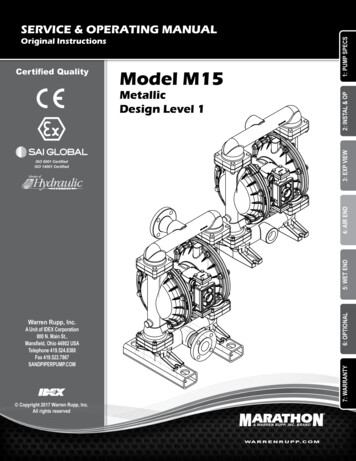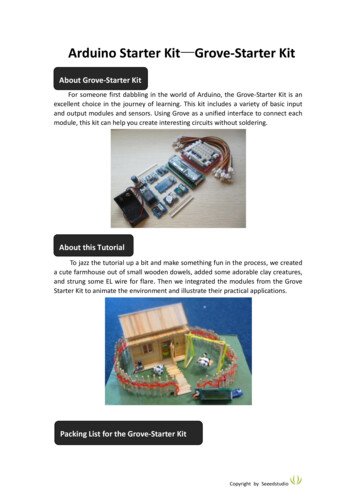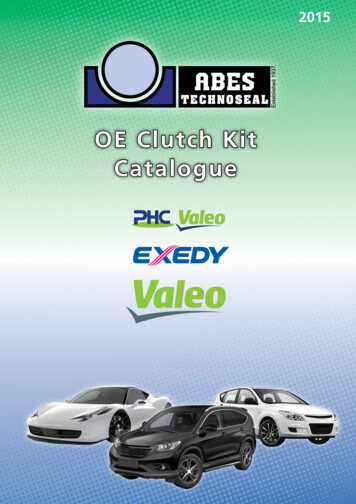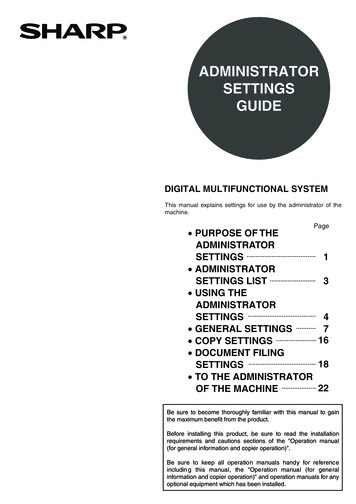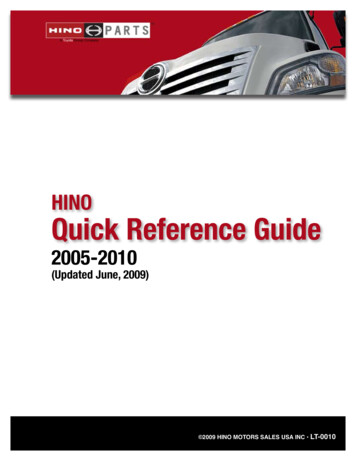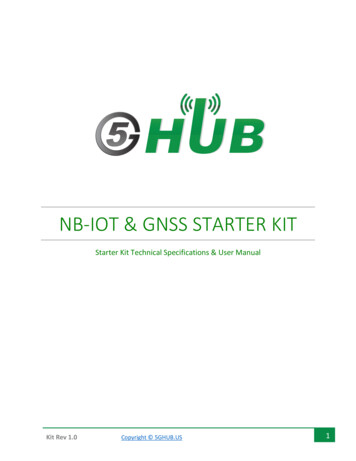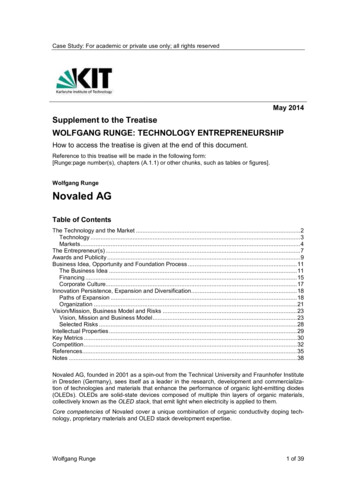
Transcription
Case Study: For academic or private use only; all rights reservedMay 2014Supplement to the TreatiseWOLFGANG RUNGE: TECHNOLOGY ENTREPRENEURSHIPHow to access the treatise is given at the end of this document.Reference to this treatise will be made in the following form:[Runge:page number(s), chapters (A.1.1) or other chunks, such as tables or figures].Wolfgang RungeNovaled AGTable of ContentsThe Technology and the Market .2Technology .3Markets.4The Entrepreneur(s) .7Awards and Publicity .9Business Idea, Opportunity and Foundation Process .11The Business Idea .11Financing .15Corporate Culture.17Innovation Persistence, Expansion and Diversification.18Paths of Expansion .18Organization .21Vision/Mission, Business Model and Risks .23Vision, Mission and Business Model.23Selected Risks .28Intellectual Properties .29Key Metrics .30Competition.32References.35Notes .38Novaled AG, founded in 2001 as a spin-out from the Technical University and Fraunhofer Institutein Dresden (Germany), sees itself as a leader in the research, development and commercialization of technologies and materials that enhance the performance of organic light-emitting diodes(OLEDs). OLEDs are solid-state devices composed of multiple thin layers of organic materials,collectively known as the OLED stack, that emit light when electricity is applied to them.Core competencies of Novaled cover a unique combination of organic conductivity doping technology, proprietary materials and OLED stack development expertise.Wolfgang Runge1 of 39
Case Study: For academic or private use only; all rights reservedThey believe to be currently the only company licensing and selling organic conductivity dopingtechnology and materials for use in the commercial mass production of display products in theOLED industry.Novaled offers to OLED display and lighting manufacturers customized solutions to optimize theperformance, power efficiency, stability and lifetime of their products while decreasing their manufacturing complexity and cost.As compared to existing liquid crystal displays (LCDs) OLED displays offer superior image quality,increased power efficiency and a thinner, lighter form factor. For instance, AMOLED (active matrix OLED) and AMLCD display characteristics and obstacles and solutions for AMOLED arepresented by Colegrove [2012].As will be seen the foundation and development process of Novaled as an internationally operating multi-disciplinary RBSU (research-based startup) has a number of special situations and approaches of the entrepreneurship process from the beginning.By August 2013 Samsung acquired Novaled for 260 million ( 347 million) [Filtz 2013].The Korean company will directly acquire a 40 percent stake in the venture-backed materialscompany. That will add to the 10 percent stake already owned by Samsung’s own venture investment arm, while Cheil Industries – a Samsung affiliate company – will take a majority stake ofapproximately 50 percent. Jan Blochwitz-Nimoth, one of the founders of Novaled is also set tosell his share in the firm. Novaled generated revenues of 26 million in 2012, meaning that thedeal values the company at around ten times its annual revenues [Optics.org 2013] which meansin mergers & acquisition language so-called “multiples” of ten.The Technology and the MarketThe transition of lighting which is already happening for light emitting diode (LED) technology[Runge:Figure I.165, Figure I.166] and organic light emitting diode (OLED) technology[Runge:Figure I.148, Figure I.149] is one of the last analogue-to-digital transitions. It was generally expected that digitization will change the lighting market similarly to digitization of the cameramarket at an average growth of ca. 30 percent [Runge:p. 461].LEDs provide point (spot) lighting. On the other hand, for area lighting OLEDs would be bettersuited rather than point lighting LED. Think entire lighting ceiling tiles rather than spots – or evenluminous wallpaper. OLED displays are the next generation of emissive technology. Related displays are composed of self-luminous pixels and require no backlights.OLED technology is among the most promising possibilities for the next generation of flat-paneldisplays (FPDs) and lighting technologies. Since early 2000 OLED products were projected togenerate a market potential of several billions of dollars [Leo and Blochwitz-Nimoth 2004; DerStern 2005]. As the infrastructure in existing liquid crystal display (LCD) production facilities canbe adapted technically rather easily for the new technology, researchers are convinced the newtechnique will allow for very cost-effective display manufacture.OLEDs as a promising new light source also for white-light systems has the technical potential tocontribute significantly to energy savings in professional and industrial environments. Hence,OLEDs show also up in the context of energy efficiency and CleanTech [Hong et al. 2005]. It isestimated that in the developed countries ca. 15 percent of electrical power is used for lighting.CleanTech aspects include: No mercury, fewer components, and more energy saving.Hence, OLED represents a key technology. But simultaneously it is also a generic technology[Runge:Table I.51] with the potential to substitute LCDs partially and LED luminaries.It was estimated that around 2000 LED/OLED products accounted for ca. 1 percent of the overallvery huge lighting market [Runge:Table I.81] and ca. 3 percent of the flat panel display (FPD)market [Leo and Blochwitz-Nimoth 2004].Wolfgang Runge2 of 39
Case Study: For academic or private use only; all rights reservedTechnologyAn OLED utilizes the principle of electroluminescence, an optical phenomenon and electrical phenomenon in which a material emits light in response to the passage of an electric current or to astrong electric field.An OLED is a light-emitting diode (LED) in which the emissive electroluminescent layer is a film oforganic compound which emits light in response to an electric current. This layer or layers of organic semiconductor(s) is situated between two electrodes [Wikipedia-1].Generally, at least one of these electrodes is transparent. Indium tin oxide (ITO) is a commontransparent anode, while aluminum or calcium is common cathode materials. Between the emissive layer and the cathode or the anode, manufacturers add other materials to enhance OLEDefficiency.Following Wikipedia-1 the key to the operation of an OLED is an organic luminophore. An exciton,which consists of a bound, excited electron and hole pair forms inside the emissive layer. Whenthe exciton's electron and hole combine, the exciton can emit a photon. Excitons are the main1mechanism for light emission in semiconductors.A challenge in OLED manufacture is tuning the device. The object of tuning is having an equalnumber of holes and electrons meet in the emissive layer. In an organic compound, this equalbalance is difficult. In such compounds, the mobility of an electron is much lower than that of ahole (Figure 1).An exciton can be in one of two states, singlet or triplet. Only one in four excitons is a singlet. Thematerials in the emissive layer are typically fluorophors. A fluorophore is a fluorescent chemicalcompound that can re-emit light upon light excitation. These materials can only emit light when asinglet exciton forms. This situation reduces the OLED's efficiency. But, for instance, by incorporating transition metals into a small-molecule OLED, the triplet and singlet states can mix byspin-orbit coupling.There are also phosphorescent based OLEDs (PHOLEDs) with a phosphorophore that use the3principle of phosphorescence (generating light from both triplet and singlet excitons).To create the excitons a thin film of the luminophore resides between electrodes of differing workfunctions. A metal cathode injects electrons into one side. An anode injects holes in the other one.An electron and hole move into the emissive layer. There, they can meet to form an exciton(Figure 1).The main challenge was to pixelate the emissive layer of an OLED display as there are threecompeting requirements:Being compatible with large substrates to satisfy the customer’s demand for increasinglylarger displaysDefining extremely fine pixel structures to meet the resolution requirements for the newgeneration of HDTV- and micro-displaysSignificantly reducing production costs compared to existing display technologies.So far display companies, in entering the OLED arena, have had a choice in manufacturing strategy either choosing fluorescent small molecule (SM) vacuum technology or fluorescent conjugated polymer (PLED) solution technology.Substrates may be glass, metals or plastics. When flexible AMOLEDs will be fabricated, for instance, on a polyimide plastic [Runge 2006:139,336], they will be shatterproof, and will also belighter and thinner compared to glass based OLEDs [Wikipedia-2].Wolfgang Runge3 of 39
Case Study: For academic or private use only; all rights reservedOLED Structure:SubstrateAnodeConductive Layer (OrganicMolecules or Polymers)Emissive Layer (OrganicMolecules or Polymers)CathodeFigure 1: General principles of OLED technology.OLED materials generally fall into two classes each with characteristic processing routes:Evaporable materials: small molecule materials – low molecular weight compounds withstandard processing by vacuum or carrier gas depositionSolution processable materials: macromolecular materials (for instance, polymers, highmolecular weight oligomers, and simple solubilized heavy metal chelate materials) can befabricated by a range of solution deposition techniques from simple coating such as spinand roll coating to printing techniques, such as ink jetting.Both technologies have developed rapidly and there now exists a number of different viable process options for each. Moreover, the materials’ situation has become even more complex with theemergence of phosphorescent (triplet) technology. This offers the prospect of OLED developmentwith exceptionally high efficiency (a factor of 3-4 times over fluorescents) while, except for a difficult Blue challenge, maintaining color purity and long lifetime for R and G. Indeed this promisingtriplet approach has been shown to be capable of being adapted to either vacuum or solutionprocesses (cf. Competition).The first observations of electroluminescence in organic materials were in the early 1950s byAndré Bernanose and co-workers at the Nancy-Université, France. The first diode device wasreported at Eastman Kodak in 1987. Kodak developed Small Molecule OLEDs. This device useda novel two-layer structure with separate hole transporting and electron transporting layers suchthat recombination and light emission occurred in the middle of the organic layer (cf. also Figure3). This resulted in a reduction in operating voltage and improvements in efficiency and led to thecurrent era of OLED research and device production. Research into polymer electroluminescenceculminated in 1990 at the Cavendish Laboratory in Cambridge reporting a high efficiency greenlight-emitting polymer-based device [Wikipedia-1].Novaled addresses 2nd generation OLEDs.PMOLED (passive matrix OLED) started shipments in 1999; AMOLED started at the end of 2002.AMOLED is expected to be the growth force for OLED in the future [Colegrove 2012].By 2004 Samsung, South Korea's largest conglomerate, was the world's largest OLED manufacturer, producing 40 percent of the OLED displays made in the world, and as of 2010 had a 98percent share of the global AMOLED market. The company is leading the world of OLED industry,generating 100.2 million out of the total 475 million revenues in the global OLED market in2006 [Wikipedia-1].MarketsThe introductory remarks about the high growth expectations of OLED markets indeed materialized. Turnover with OLEDs in the European markets in 2009 was ca. 120 mio. per year and wasWolfgang Runge4 of 39
Case Study: For academic or private use only; all rights reservedprojected to increase to more than 680 mio. Global revenues were assumed to reach 2.45 bil.in 2008 [BMFB 2010].Related to its state-of-the-art by 2008 OLED technology exhibited the following benefits compared to existing technologies [Böhme 2008]:Ultra Thin ( 150 nanometer)Excellent color and contrastNearly 180 viewing angleLarge area diffuse light sourceTransparent.But in the lighting world there emerged a new paradigm [Muth 2010]:Flat thin area light source which emits light over the whole surfaceDual nature of OLED: Fusion of lamps and luminaries, reducing system complexity.According to market research firm NanoMarket characteristics of the developments of corresponding markets in February 2007 are given in Table 1.Table 1: Growth forecasts of OLED markets when Novaled was in an early phase of growth[Böhme 2008].Market2008Total OLED Display Revenue Forecast ( bill.)20122.68010.115Worldwide OLED TV Revenue Forecast ( mil.)423,391OLED Lighting and Signage Revenue Forecast ( mil.)75846As given by Böhme [2008] the global lighting market was over 90 mil. in 2006 (supplier level).The lighting market is concentrated at front-end (lamps) and fragmented at back-end (luminaries).There are few lamp types but a wide variety of luminaries’ types. Lamps as a light source accountfor ca. 20 percent of the whole market with three big players: Dutch Philips, German Osram andUS General Electric (GE). Luminaries (lighting systems) comprising ca. 63 percent has manysmaller players and a high level of regional and domestic luminaries’ production.Generically, the opportunities for lighting products comprised [Böhme 2008]:Light to illuminate “things” (designed objects, architectural elements etc.)Special lighting (decorative, machine vision )General illumination (office lighting, room lighting )Transparent windows.And people are convinced that OLED will modify the value system for lighting [Muth 2010,Blochwitz-Nimoth 2011]. Lamps and luminaries will converge and induce1.2.3.4.Flat (and flexible) area light sources for revolutionary designsLight sources with low power consumptionNew playersNew business opportunities.OLED can also be combined with other hot technologies, such as touch screens, e-paper displays, and 3D [Colegrove 2012].Recent market research corroborates what was expected around 2000 concerning market developments and opportunities of OLED [Colegrove 2012; SEC 2012].The market for OLED flat panel display products is growing rapidly and is rapidly gaining marketshare in the flat panel display market. Market research firm DisplaySearch set the market shareof OLED displays as having grown from 0.6 billion (in 2008 1 percent of the flat panel displayWolfgang Runge5 of 39
Case Study: For academic or private use only; all rights reservedmarket) to 3.7 billion in 2011 (almost 4 percent of the flat panel display market) which representsa compound annual growth rate (CAGR) [Runge:Equation I.10] of 83 percent.Although OLED displays are currently more expensive to manufacture than LCD and plasma displays, many industry analysts believe that OLED displays represent the future of the display market due to their superior image quality, form factor and power efficiency as compared to existingliquid crystal displays (LCDs) and plasma displays. Market research projected global OLEDdisplay revenues to increase from 1.6 billion in 2010 to 25.5 billion in 2018 at a CAGR of 41percent.Transparency Market Research [2013] expected the global OLED displays market to reach 25.9billion by 2018 from 4.9 billion in 2012 growing at a CAGR of 31.7 percent from 2012 to 2018.Mobile phones are the largest end use application and accounted for 71 percent of the totalOLED displays market in 2012, but the share of OLED TV displays are expected to surpass theshares of mobile phone displays by 2015.According to Colegrove [2012] small-sized OLED displays (primarily the active-matrix OLED,AMOLED) have achieved significant penetration in the smartphone market, and, according todata also provided by International Data Corporation and DisplaySearch, are estimated to account for approximately 17 percent of total smartphone sales in 2011. They are also used fordigital cameras (DSCs – digital still cameras), mobile media players (PMP) and car audio display.Medium-sized OLED displays are being introduced in tablet personal computers (tablets).Samsung Mobile Display (SMD) and LG Display, the leading flat panel display manufacturers,have recently announced plans to launch large-sized OLED televisions for the high-end consumer market. Large-scale displays for promotional and advertising purposes (public signage)are also of interest.Overall OLED shipments are forecasted to be 250 million in 2012, reaching 776 million in 2018[Colegrove 2012].Commercial interest in OLED lighting products is also strong. As OLED devices efficiently produce diffuse, homogenous light from a flat, thin surface, they offer new opportunities for lightinginstallation and design. It is estimated that the nascent OLED lighting market will develop into atleast a 3.5 billion global market by 2018, and DisplaySearch and NanoMarkets project that theOLED lighting market will be 1.5 billion by 2015 and develop into a 6.2 billion and 9.9 billionglobal market, respectively, over the same period. The Dutch firm Philips, for example, recentlyconfirmed its intention to offer decorative and performance lighting products based on OLEDtechnology [Colegrove 2012].The opportunity for OLED lighting is evolving. Europe is currently the leading participant in theOLED lighting in terms of organization/projects numbers, government funding, and participatingcompanies. Over 100 companies and universities are working on OLED lighting currently, notablyOsram, Philips, Lumiotec, GE, and Kinoca Minolta. Opportunities emerge by diversification ofOLED lighting for different applications [Colegrove 2012].OLED display revenue will continue to be bigger than OLED lighting in the forecast period.Overall OLED lighting advantages are now seen to cover [Colegrove 2012]:High efficiency for energy savingThin, light weightArea/surface lighting: flexible or rigid form factorLong life time for less frequent replacementTunable color for decorative use and color matchingFast switch onWide temperature operation range for use in extreme environmentsLow drive voltage for better power, smaller power supplyNo noiseEnvironmentally friendlyOLED lighting can be transparent like a window or reflective like mirrors.Wolfgang Runge6 of 39
Case Study: For academic or private use only; all rights reservedOLED lighting faces different challenges from displays [Colegrove 2012:23].Prices for OLEDs are decreasing continuously. By 2010 an area of 100 square centimeters costca. 1,000. By 2011 commercially available OLEDs with an area of 50 square centimeters cost ca. 200 per piece. For displays, production has tripled in the past twelve months, and will doubleagain in the coming year [Miethke 2011].Cost of using OLEDs for displays of smartphones means higher cost of 10 percent for production.But a smartphone does not consist solely of a display. Therefore, higher cost may be hidden orleveled off by other components. On the other hand, for TV screens production facilities usingOLEDs need to be built to let cost sink (“economy of scale”) [Miethke 2011].The Entrepreneur(s)The research-based startup (RBSU) Novaled was founded as a spin-out from the Technical University of Dresden (TUD) and a Fraunhofer Institute in Dresden (Germany) in 2001, at first withthe legal status of a limited liability company (LLC, GmbH in Germany).The founders were [Blochwitz-Nimoth 2009; Blochwitz-Nimoth 2011] centered around the entrepreneurial professor Karl Leo providing links between OLED startup Novaled and organic semiconductor startup Heliatek and links between TUD and FhG-IPMS (Fraunhofer-Institut fürPhotonische Mikrosysteme – Fraunhofer Institute for Photonic Microsystems).Table 2: The founder team of Novaled.Prof. Dr. Karl Leo(Professorship for Optoelectronics at TUD and Deputy DirectorIPMS)Prof. TUD-IAPP (Institute for Applied Photo Physics) andaffiliated at a Fraunhofer Institute;involved in spin-outs: CreaPhys, Novaled, Heliatek, Sim4Tec,LedOnOLEDDr. Jan Blochwitz-NimothPhD at IAPP on PIN-OLEDsDr. Martin PfeifferPhD at IAPP on doped organic semiconductors;co-founder of HeliatekJörg AmelungPhysics, University of Darmstadt, (FhG-IPMS)electronics;co-founder of LedOnOLEDKey characteristics of an entrepreneurial professor for technology entrepreneurship are not just abusiness mindset, but also revealing, supporting and encouraging entrepreneurial talents. In caseof OLED it was Dr. Jan Blochwitz-Nimoth.Founders of technology ventures need to be persistent and have much patience. According toLeo “At the university focusing on know how of founding a venture being taught with praxisorientation, I think, is ideal.” (An der Hochschule das Knowhow für eine Unternehmensgründungpraxisorientiert vermittelt zu bekommen, halte ich für ideal.) [Eckold 2005].His advice for technology entrepreneurs is:The be-all and end-all is people with the right qualifications! With us, they must not onlybe first-class physicist, but also communicative and entrepreneurial tip. (“Das A und Osind Leute mit der richtigen Qualifikation! Bei uns müssen sie nicht nur erstklassigePhysiker, sondern auch kommunikativ und unternehmerisch spitze sein.”) [Eckold 2005]Prof. Karl Leo is Germany’s poster child when it comes to co-founding new smart green startupsout of university. His basic attitude is that for a scientist it is a great satisfaction when he sees thathis physical concepts will be implemented commercially (Es ist “für einen Wissenschaftler einegroße Genugtuung, wenn er sieht, dass seine physikalischen Konzepte wirtschaftlich umgesetztwerden.”) [Eckold 2005].Wolfgang Runge7 of 39
Case Study: For academic or private use only; all rights reservedKarl Leo received his Dr. rer. nat. degree in 1988 at the University of Stuttgart. In 1993 he did hishabilitation thesis at the Institut für Halbleitertechnik (Institute of Semiconductor Technology) ofthe Technical University (RWTH) of Aachen. In the same year he was appointed Professor forOptoelectronics at the Institute of Applied Photophysics (IAPP) of the Technical UniversityDresden. Since 2001 he was Head of the business unit “Organic Materials and Systems” at theFraunhofer IPMS.In September 2007 the Executive Board of Fraunhofer-Society appointed Prof. Leo as a furtherdirector of the Fraunhofer Institute for Photonic Microsystems with emphasis on “Organic Materials and Systems.”Since July 2012 he is the Leader of Fraunhofer COMEDD. The Fraunhofer Research Institute forOrganics, Materials and Electronic Devices COMEDD was founded as an independent researchinstitution of the Fraunhofer-Society in order to transfer results of research and development inthe field of organic materials and systems to production.Similar to Leo, in hindsight Blochwitz-Nimoth [2009] re-affirmed that the spin-out was a gooddecision. And he confirmed that it is a great pleasure and a big adventure to see such a firmgrowing, its employees further developing and pursue applied technology.According to Novaled’s Web site, Jan Blochwitz-Nimoth (born in 1970 in Dresden/Germany)studied physics at the TU Dresden and the University of Oldenburg. He completed his diplomathesis at the Institute for Applied Photo Physics (IAPP) of the TU Dresden in the field of ultrashort laser spectroscopy. Afterwards he worked for one year on inorganic optoelectronic and lightprojection devices. While working on his PhD at IAPP, he conducted intensive research on applications of doped charge transport layers for OLED. He successfully completed his PhD in July2001. With his outstanding know-how of doped charge transport layers for OLED Jan BlochwitzNimoth is a key inventor of the Novaled PIN OLED technology and became a co-founder ofNovaled.Novaled showed a clear pre-startup phase of R&D which led ultimately to the idea to turn theR&D results into a business [Blochwitz-Nimoth 2009].Novaled is based on the one hand on research on organic semiconductors of Martin Pfeifer at theIAPP TUD, during 1992-1995. He could rely on previous work on vapor-depositable dyes for CCDcolor filter (charge-coupled device). Another co-worker at IAPP already started to deal withorganic transport materials. Early working conditions of these people were rather poor. Thatchanged, however, drastically in 1993 when Karl Leo became professor at the IAPP and organicelectronics became the focus of the institute.Introducing organic chemistry into the electronics field, however, meant that completely differentdoping materials have to be used so that the premise behind Martin Pfeiffer’s dissertation wasinitially a search for suitable doping materials. The first experiments already revealed that theprinciple of doping can also be transferred to organic semiconductors. In 1996 first results forusing selectively large organic molecules for doping organic semiconductors were achieved.These showed a stable increase in conductivity of holes contrary to doping with gases and metalstried to far, but for which increased conductivity disappeared rather fast.“Yet the work also met with a lot of skepticism. Experts were initially condescending when theyheard about the idea from Dresden: One expert from a renowned institute even stated that thecomponents could only become worse due to doping. That was motivation enough for theteam from Dresden to go on to prove that doping can considerably improve the components:They succeeded in lowering the operating voltage of organic light-emitting diodes (OLEDs) bymore than a factor of two and thereby considerably improved component efficiency.” [DZP11]Skepticism referred also to “doubts whether you can ever thus come through production. Againstthese doubts we had to fight as a founder team which has now been nominated {for the GermanFuture Award}. The headwind at the university was really very strong. But we have shown that itworks. That let emerge imitators and envious persons,” said Blochwitz-Nimoth [Miethke 2011].Wolfgang Runge8 of 39
Case Study: For academic or private use only; all rights reservedThis was the status of research when Jan Blochwitz-Nimoth joined the IAPP team to researchdoping effects in OLEDs. The goal was to construct OLEDs better than the existing ones.Transfer and EU financing became available to get more sophisticated facilities for research andcorrespondingly also better results were achieved.The basic attitude and conviction generated by Jan Blochwitz-Nimoth during his dissertation workwas that experimental physicists should work like engineers: much construction work, muchtinkering, much development of methods and devices/instruments, but always with the goal toconstruct OLEDs which are better than those built before (“continuous improvement”).As Dr. Blochwitz-Nimoth then using this method was able to show in his thesis that highly efficientOLEDs can be prepared that surpass classic lighting elements such as the light bulb or evenfluorescent lamps, the breakthrough of the technology was in sight [DZP11].In 2001 the OLED results of Blochwitz-Nimoth were summarized and consolidatedestablishing a basis: OLEDs with significantly lower operation voltage and competitiveefficiencies can be obtained by doping.During discussions between related IAPP people (Table 2) with Jörg Amelung from IPMS joininglater the group agreed to the opinion that it would be a pity to stop working in the area and just tocontinue with “basic research” and to observe how others in the world will utilize their “dopingtechnology” for OLED products. All were convinced that exactly t
ally expected that digitization will change the lighting market similarly to digitization of the camera market at an average growth of ca. 30 percent [Runge:p. 461]. LEDs provide point (spot) lighting. On the oth


